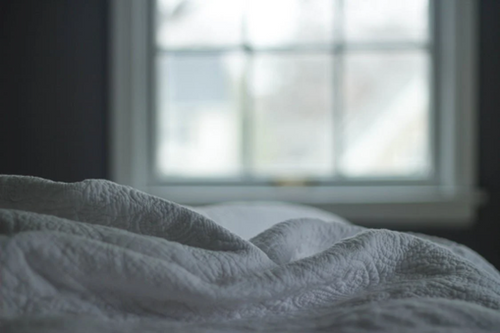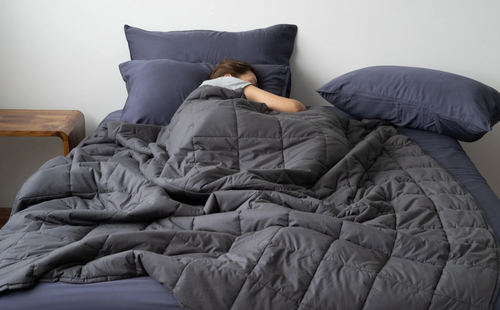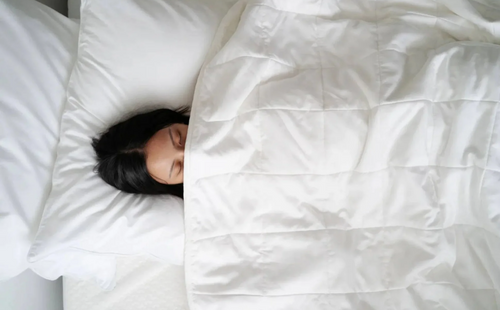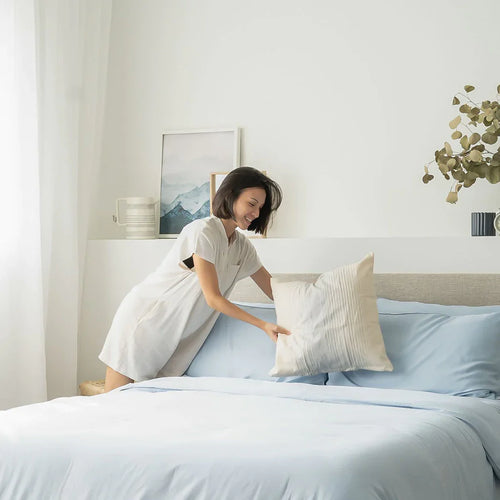At a Glance
If you're looking to buy a blanket, you'll likely encounter terms like TOG, fill type, fill power, and weight. But what really are they? Let this post demystify them for you!
Quick Tips
- Know what the numbers these blanket terms represent.
- Most of these concepts determine warmth and insulation.
- Look into of key specifications before making a purchase.
There’s no denying the comfort of snuggling into a blanket in Singapore after a long day. However, some heavy and overly warm blankets may seem impractical in light of the city’s sweltering heat.
Buying a duvet in Singapore can also sound like an arduous and futile task given the many options and terminologies that define the best blanket quality.
Understanding the different bedding terms and concepts is key to choosing the best blanket in Singapore. In this guide, we break things down for you on the top features to watch out for - from TOG, fill type, fill power, and weight.
What Is A Duvet?
A duvet is a two-piece blanket composed of the duvet filling and a removable duvet cover. A cotton duvet is most common, but for those looking for a hypoallergenic, breathable, and sustainably-made option, you might want to check out Lyocell duvets.

Featuring Weavve’s TENCEL™ Lyocell Duvet
In some ways, a duvet is like a mix between a quilt and comforter. But there are more differences between a duvet vs comforter vs quilt you should take into consideration.
Duvet Vs Quilt
Significantly thinner than a duvet, a quilt may be good for warmer climates. It is a thick blanket that consists of three layers. The top layer is usually made out of pieces of fabrics sewn together to become one sheet. The middle layer is the filling material which gives quilts its fluff and warmth. This is then closed in by the bottom layer in a material similar to the top.
These three layers are quilted together to become one in intricate patterns that keep the padding intact while giving the quilt its unique character. Common materials include cotton blanket or fleece blanket layers quilted together.

Image by Tirachard Kumtanom from Pexels
However, it may come off a bit dated for those looking for a modern bed blanket. Its quilting design makes for a more secure distribution of filling across the blanket for less fuss, but as a one-piece blanket, it may be more challenging to launder regularly.
In the olden days, quilts were made with much significance to their owner - usually given as a gift for significant events such as in marriage or when having children. Today, quilts are easily accessible and have appropriate variants for any season.
Duvet Vs Comforter

Image by Andrea Piacquadio from Pexels
Both are thick and fluffy blankets, but duvets opted out of the grid-like quilting of comforters, resulting in a more rugged look. And just like quilts, comforters consist of top and bottom fabrics which usually contain synthetic filing materials such as polyester or cotton. These are then sewn together in wide square patterns. As such, comforters are much fluffier and heavier - think of the blankets we see in hotel beds.
A comforter blanket is a great way to combine both style and function. Because of its sheer size, comforters are rarely folded and stored. It can act as a substitute for your bed topper, making it perfect for those who have no time to make their beds.
Moreover, duvets in Singapore keep inside and outside pieces separate. Changeable duvet covers provide ease of washing and flexibility in bed designs to match your changing taste.
Weighted Blanket

Featuring Weavve’s Weighted Blanket
Also known as a gravity weighted blanket, this blanket is body weighted between 5 and 30 pounds. The extra blanket weight aids greatly in executing deep touch pressure, a successful technique to calm those with sensory processing disorders or autism spectrum disorders. The gentle pressure of a gravity blanket acts like a hug, releasing feel-good chemicals in the brain to relax those feeling overwhelmed and overstimulated.
The benefits of a weighted blanket move beyond those with mental health and neurological conditions. The use of weighted blankets for anxiety has been shown to help improve sleep quality and alleviate chronic pain.
Owning a gravity blanket in Singapore is key to soothe busy professionals or anxious children as they go through everyday struggles. Hence, proving that weighted blanket benefits are as amazing as how the material feels.
What Makes Quality Blanket?

Featuring Weavve's Weighted Blanket
Once you’ve narrowed down to which type of blanket you prefer, you’ll also have to navigate through some of the terms that will help you determine the specifications truly suited for your needs.
TOG (Thermal Overall Grade)
TOG measures how well a duvet can insulate heat. This is determined not by the thickness of the blanket, but the material used. Whether through synthetic or natural filling, the ability to trap air varies across all types of filling options.

Image by Yan Krukov from Pexels
TOG ranges from 1 to 15, with 1 being the coolest and 15 the warmest. The right tog varies per season - 2.5-4.5 for warmer months and 10.5-13.5 for colder months. There are also all-season duvets which combine two duvets of differing togs for increased flexibility. Ultimately, the best tog rating is determined by your personal preference, room temperature, climate, and other factors.
Fill Type
Fill type refers to the type of filling placed inside your duvet. These are usually divided into two categories - natural filling and synthetic filling.

Image by Isabelle Taylor from Pexels
Natural fillings feature super soft, warm and breathable materials such as down and feather. These also feature high thermal insulation, taking less material to achieve the desired warmth in order to create a lighter blanket. On the other hand, synthetic fillings such as microfibers or glass beads are hypoallergenic, lessening the incidence of itching or allergies caused by irritants.
Fill Power
Also known as loft, fill power is an indication of how much space is taken by the filling in a duvet - in short, how fluffy it is. Fill power ranges from 450 to 900 cubic inches (CUIN), with good duvets ranking in at least 600 CUIN. Fill type helps determine fill power, as the blend and quantity of filling materials is what causes the fluff we see in duvets.

Image by Anna Tarazevich from Pexels
Fill power also sheds light on other duvet specifications. Duvets with higher fill power will weigh less, get back into shape quicker, making it last longer for everyday use. Especially for duvets with natural fillings, fill power can also be a good indicator of tog - the higher the fill power, the more effectively a duvet can keep you warm.
Fill Weight
Fill weight determines how heavy a duvet is, often denoted in grams per square meter (gsm). It is important to note that a heavy duvet doesn’t equate to a warm duvet - with poor materials or blending, it is possible for a duvet to have high density and provide poor insulation. However, comparing across similar blends of filling materials, fill weight can help you determine which blanket will warm better.

Instead of using fill weight as an indicator of warmth, use this metric as a barometer of convenience. At what weight would a duvet’s warmth outweigh the extra effort of carrying it to and from the bed or the laundry? Warmer climates can do with 200gsm, while cooler climates can go as heavy as 500gsm.
Importance Of Knowing These Blanket Terminologies

Image by Ivan Oboleninov from Pexels
There are many types of high quality blankets fit for Singapore sleepers - from quilts, comforters, duvets to weighted gravity blankets.
Moreover, not all blankets are created equal, so it pays to be aware of key specifications before investing in one. With these tips at your disposal, you can find your perfect blanket with confidence.
DISCOVER WEAVVE’S BLANKET COLLECTION
Weighted Blanket
Our weighted blanket is made of smaller compartments for evenly distributed weight, which promotes relaxation by simulating the sensation of being held or embraced.

Featuring Weavve’s Weighted Blanket
The weighted blanket's deep touch pressure is intended to give you a sense of security, relaxation, and comfort. With a breathable fabric that is machine-washable and dryer-safe, it is hypoallergenic and non-toxic.
-
Shop weighted blankets Singapore
TENCEL™ Lyocell Duvet
The first of its type in Singapore, our TENCEL™ Lyocell duvet offers 100% pure TENCEL™ Lyocell fibers in both its outer fabric and inside filling. This composition provides excellent temperature regulation properties for the most comfortable sleep.

Featuring Weavve’s TENCEL™ Lyocell Duvet
For both the erratic hot and cold weather, we developed this innovative bedding product to help every Singaporean "feel 100% all the time."
-
Shop TENCEL™ Lyocell duvets Singapore
RESPONSIBLY MADE
Here at Weavve, we pride ourselves on being committed to responsible sourcing, production, sale, and use of our products. We take great effort in ensuring that our decisions account for all the people who help build our products, the environment, and our consumers. From Standard 100 by Oeko Tex® certified sheets to SEDEX certified factories, Weavve makes sure that everyone is cared for at every step of the way.





































